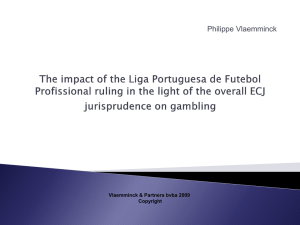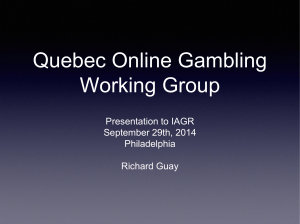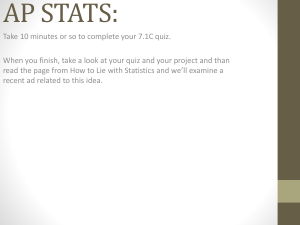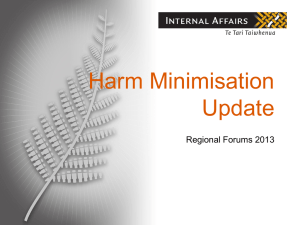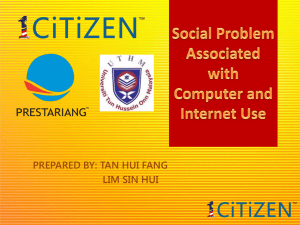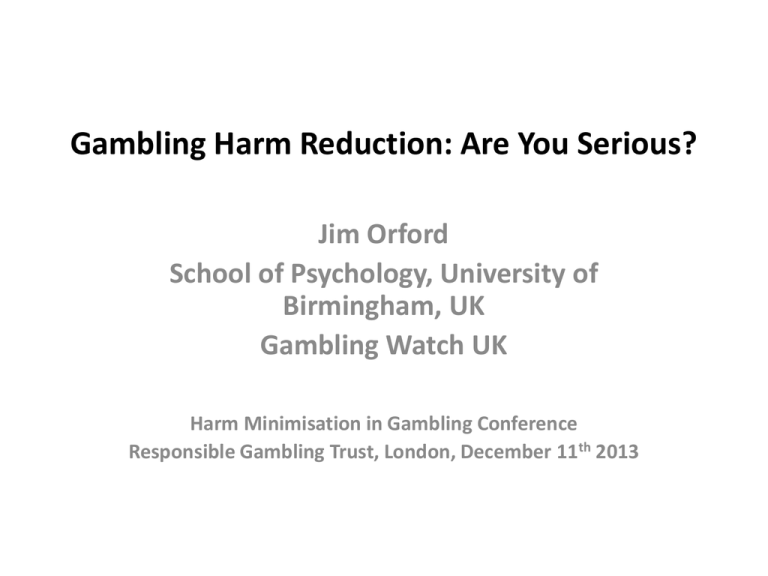
Gambling Harm Reduction: Are You Serious?
Jim Orford
School of Psychology, University of
Birmingham, UK
Gambling Watch UK
Harm Minimisation in Gambling Conference
Responsible Gambling Trust, London, December 11th 2013
Forms of harm from gambling
Form of harm
Harm to individuals who gamble
A continuum of risky and harmful
gambling
Harm to their family members
Financial, relational and emotional harm
Harm to the community
Harm to the quality of the high street,
financial drain, community health affected
Harm to society
Normalisation of gambling, risks to young
people, contributes to inequality
The gambling risk/harm continuum according to the
Canadian Problem Gambling Severity Index (PGSI)
•
•
•
•
PGSI score 0
PGSI score 1-2
PGSI score 3-7
PGSI score 8 plus
Non-problem gambler
At risk (low)
At risk (moderate )
Problem gambler
The gambling control continuum according to
Dickerson and O’Connor, Gambling as an Addictive
Behaviour, Cambridge University Press, 2006
• Never strong impulses, no problems
• Sometimes strong impulses, easily resisted, no problems
• Sometimes strong impulses, can resist with effort, no
problems
• Often strong impulses, difficult to resist, few minor problems
• Strong impulses, difficult but not impossible to resist, several
problems
• Frequent strong impulses, impossible to resist, several
significant distressing problems
Natasha Schüll, Addiction by Design: Machine
Gambling in Las Vegas
(2012, Princeton University Press)
By the mid-1990s, the gambling industry had already
grasped... that a medical diagnosis linked to the
excessive consumption of its product by some
individuals could serve to deflect attention away from
the product's potentially problematic role in promoting
that consumption, and onto the biological and
psychological vulnerabilities of a small minority of its
customers (page 261).
Martin Young, Statistics, scapegoats and social
control: A critique of pathological gambling
prevalence research, Addiction Research and
Theory, 2013, 21, pp.1-11
• … the industry is dependent on the pathological
gambler to … absolve itself from the harm it
produces…
• … problem gambling prevalence surveys… construct
and mobilise the pathological gambler as the object
of policy and intervention
Forms of harm from gambling
Form of harm
Harm to individuals who gamble
A continuum of risky and harmful
gambling
Harm to their family members
Financial, relational and emotional harm
Harm to the community
Harm to the quality of the high street,
financial drain, community health affected
Harm to society
Normalisation of gambling, risks to young
people, contributes to inequality
Affected family members: a group with no voice
• ‘It is the nature of emotional disorders that when
one member of the family is afflicted, the effects
are felt by all the others. There are few, however,
in which the impact is felt with such severity as in
the case of compulsive gambling’ (When Luck
Runs Out, Custer & Milt, 1985).
• ‘… we have had a monster living with our family –
a monster in the shape of a fruit-machine.
Practically every penny my husband earned went
into that machine’ (a wife cited by Barker &
Miller, 1968).
Forms of harm from gambling
Form of harm
Harm to individuals who gamble
A continuum of risky and harmful
gambling
Harm to their family members
Financial, relational and emotional harm
Harm to the community
Harm to the quality of the high street,
financial drain, community health affected
Harm to society
Normalisation of gambling, risks to young
people, contributes to inequality
A sample of British attitudes towards gambling in 2010
(percent agree or disagree)
80
70
60
50
40
Agree
30
Disagree
20
10
0
People should
Too many
Gambling should On balance
have the right to opportunities to be discouraged gambling is good
gamble
gamble
for society
Types of gambling harm reduction measures
Reduce gambling by
reducing demand
Reduce gambling by
reducing supply
Harm reduction that does
not require a reduction in
gambling
Education campaigns
Limit availability
Reduce criminality by
legalisation
Controls on advertising
Limit accessibility
Help for affected family
members
Player-centred e.g. preModify gambling features
commitment, self-exclusion
On-site crisis intervention
Three types of evidence (Glasby, 2011) and their
relevance to High Stake-High Prize Electronic
Gambling Machines (HS-HP EGMs) such as Fixed Odds
Betting Terminals (FOBTs)
Theoretical evidence
HS-HP EGMs have features that would
lead us to expect them to have high
harm potential
Experiential evidence
Gamblers and their family members are
telling us that HS-HP EGMs are causing
particular harm
Empirical evidence
Evidence from the 2007 and 2010 BGPSs
support the conclusion that HS-HP EGMs
are specially harmful
Gross Gambling Yield (GGY) from some different forms of British
Gambling 2010-11 and losses attributable to People with Gambling
Problems (PGPs) 2010
•
•
•
•
•
•
•
•
•
•
•
•
•
•
•
•
GGY
£m
% of losses
from PGPs
amount of losses
from PGPs £m
FOBTs in betting shops
1,295
23
297
Table games in casinos
685
11
76
Betting on dog races
275
27
75
Betting on horse races
810
7
57
Slot machines in arcades
396
12
47
Football pools
324
6
18
Bingo
386
4
16
Models of the evidence and policy relationship
(Monaghan, Evidence versus politics, The Policy Press, 2011)
• Linear or rational model: a linear process from defining a problem
to identifying missing knowledge to acquiring research, interpreting
it and then making a policy choice
• Enlightenment model: a process of 'indirect diffusion' whereby an
entire body of research or evidence, accumulating over time,
sensitises policymakers to new issues
• Evolutionary model: 'survival of the fittest': ideas that fit the
interests of powerful groups will be picked up and those that do
not, will not
• Political or tactical model: new research is unlikely to have a bearing
on predetermined positions allied to various interests and political
ideologies
• Interactive, dialogic or processual models: concepts and therefore
knowledge are inherently contested and meaning emerges from
negotiation and dialogue between relevant constituents
Two contrasting policy perspectives
• Gambling is seen as an
ordinary entertainment
product
• In Government, the
department responsible
for Culture and Sport
should take the lead
• The industry should sit at
the policy table and fund
prevention, treatment
and research (PT&R)
• Gambling is seen as a
commodity dangerous to
health
• In Government, the
department responsible
for Health should take the
lead
• Policy formation should
be independent of the
industry and PT&R should
be funded by government
Dr Margaret Chan, Director General World
Health Organization, Doctors and the
alcohol industry: an unhealthy mix?
British Medical Journal, 2013
• In the view of WHO, the alcohol industry has
no role in the formulation of alcohol policies,
which must be protected from distortion by
commercial or vested interests.
Responsible Gambling Strategy Board
Strategy 2012
• … whether bespoke harm-prevention measures
might be effective… player-centred measures
tailored to a gambler’s actual machine play… in
contrast to the current across-the board
regulatory controls, such as limits to stakes and
prizes and number and location of gaming
machines (para 49)
• … wider societal risks… recession… low income
groups… important contextual considerations…
probably too broad and complex to prioritise for
research (para 52)
www.gamblingwatchuk.org


